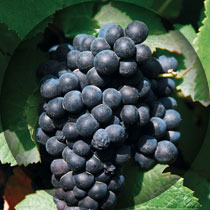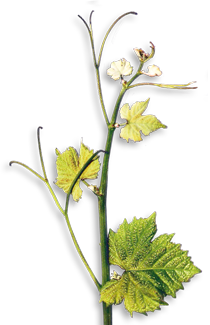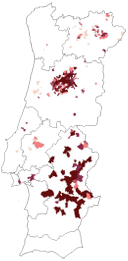Alfrocheiro (PT)
Variety: red | Category II | Portugal


General Information
Alfrocheiro


Origin: Variety of unknown origin, which first appeared in the literature in the 20th century. Until then, it was known solely as a white variety. Based on its low genetic variability, it is assumed that it could be a new, or – in the opinion of other authors – an imported variety. Truel (1986) does not believe that it could be from the Pinot family, although there is a certain similarity in the leaves, and he therefore is also of the view that it was probably erroneous to accord it synonymity with the Tinta Francisca de Viseu. The Alfrocheiro appeared in the Dão after the Phylloxera outbreak, and later in the Alentejo, with the intention of being used as compensation for the weak colour of the Moreto. The variety then appeared in the Ribatejo and the Bairrada. New information has come to light that this variety exists in Spain under another synonym.
Chief areas of distribution: Dão.
Official synonym(s) (national and OIV): Not yet determined.
Historic and regional synonyms: Alfurcheiro, Alfrocheiro Preto, Tinta Bastardinha (ex. Nº 289), Tinta Francisca de Viseu.
Homonym(s): Seabra (1791) described a white variety (as did Silva and Telles, 1790; and Vila Maior, 1875). According to A. Augusto Aguiar (1866), the white Alfrocheiro was the historical synonym for the Douradinho.
Area under cultivation: 1,850 ha.
New plantings: 3.3%.
Trend: Upward.
Varietal variability: Medium to low.
Availability of propagating material: RNSV polyclonal material available; certified clone 41 JBP available.
Molecular Profile (OIV)
Regional Classification
Morphology
Phenology
Vegetative Potential
Viticultural Parameters
Oenology
Variety Characteristics
| VVMD5 | VVMD7 | VVMD27 | VrZag62 | VrZag79 | VVS2 | ||||||
| Allele1 | Allele2 | Allele1 | Allele2 | Allele1 | Allele2 | Allele1 | Allele2 | Allele1 | Allele2 | Allele1 | Allele2 |
| 226 | 238 | 249 | 253 | 179 | 189 | 188 | 200 | 251 | 251 | 145 | 153 |
DOC quality wine: Bairrada, Dão, Granja, Amareleja, Borba, Évora, Moura, Redondo, Vidigueira.
Regional wine: Minho, Beiras, Estremadura, Ribatejana, Terras do Sado, Alentejano.
Young shoot (form of tip): Open, medium anthocyanin colouration.
Young leaf: Well-balanced anthocyanin colouration of upper side of blade: low to anthocyanin colouration of first six leaves, vein formation varies from low to high, depending on location.
Inflorescence (sex of flower): Hermaphrodite.
Mature leaf: Medium size, blade circular in shape, completely overlapping lobes, medium green on upper side of blade, profile involute, no undulation between main veins. Small convex teeth. Slightly overlapping petiolar sinus. Low anthocyanin colouration of main veins.
Berry: Small, uniform, round, uniform blue-black colouration, skin of medium thickness. Flesh colourless, firm, very juicy.
Time of bud burst: Second half of March, 2 days after the Castelão.
Flowering: End of May, 1 day after the Castelão.
Berry (colour change): colour change: Second half of June, approximately 5 days after the Castelão.
Berry (harvest ripe): harvest ripe: Second half of September, five days after the Castelão.
Vigour of shoot growth: Medium.
Pruning weight:: 3 - 4 t/ha.
Shoot attitude (habit): Semi-erect.
Length of internodes: Medium, regular.
Shoot length: Varies between short and long, sometimes with poor lignification.
Tendency to form lateral shoots: Medium.
Rate of multiple bud bursts: Fairly low.
Bud fertility index: Medium, 1.37 flowers per shoot. J. Araújo speaks of high fertility.
Yield: High, index = 246 (J. Araújo), (10,000 -15,000 kg/ha). RNSV statistical values: 1.51 kg/vine (Average of at least 40 clones in Mangualde over 7 years).
Yield consistency: Irrigation in the year following high yields may resulted in a low yield. Very consistent yields in dry conditions.
Crop uniformity: Uniform.
Winkler Index: 1,639 for a 12.5 t/ha yield (Montemor).
Sensitivity to abiotic factors: Sensitive to lack of boron, and drought stress.
Susceptibility to fungal diseases: Medium susceptibility to Peronospora, Oidium and Esca; very susceptible to Botrytis.
Systemic viral infection prior to selection: 30% GLRaV-3, 30% GFkV, < 50% RSPV.
Susceptibility to Pests: Somewhat susceptible to the vine leafhopper.
Bunch size: Small (100 g).
Bunch density: Dense.
Berry skin: Thin; berry shrivels under drought stress.
Seeds per berry: High; on average, 2.3.
Vineyard conduction system: Suitable for any training system, but because of the fertility of the basal buds, training systems requiring short canes are recommended.
Soil requirement: Sandy, less fertile soils. Dense or clay soils unsuitable.
Climatic requirements: Preferably no water stress or extreme sunshine.
Vine density: Normal.
Rootstock: Very compatible with R 110, P1103, Ru140, 420 A, 5BB and SO4.
Irrigation: Recommended in dry soils.
Incidence of coulure/millerandage: Low.
Spoilage of mature berries: Risk of blue mould rot because of frequent multiple budbursts. Risk of berries shrivelling.
Risk of bird damage: Low.
Machine harvest suitability: Recommended at low temperatures only.
Wine type: Quality wine and table wine; rosé wine when alcohol content is low.
Potential alcohol content: verage content: 11 - 14% Vol; problems occur with excessive yield. RNSV statistical values: 12.48% vol. alcohol (Average of at least 40 clones in Mangualde over 7 years).
Natural acidity of must: In hot, dry areas, average value is 4.0 – 5.5 g/l; in the Dão, 6 -7 g/l. RNSV statistical values: 6.06 g/l (Average of at least 40 clones in Mangualde over 7 years).
Total anthocyanins: (RNSV statistical value: 564.25 mg (Average of at least 40 clones registered in Mangualde over 7 years).
Total phenols index (at 280 nm) of must: (RNSV statistical value: 22.97 (Average of at least 40 clones in Mangualde over 7 years).
Risk of oxidation of must: Medium.
Colour intensity of wine: Medium to high (4.00).
Wine colour tonality: 0.83.
Total polyphenol index (at 280 nm): (24.9)
Risk of oxidation of wine: Low.
Aromatic profile: Wines of the Alentejo were analysed (Hogg, 2003) and found to have higher terpenoid values that other varieties (11μg/l linalool, 5.2 μg/l citronellol, 3.7 μg/l nerol, 4.4 μg/l gernaiol).
Ageing Potential: Wines from warm zones have medium ageing potential, and should be consumed within five years. By constrast, wines from the Dão age much better.
Blending recommendation: Wine used in blends with the Vinhão, Bastardo, and Touriga.
Wine Descriptors: "The young wine in particular has an intense garnet colour with light violet reflexes, a strong but delicate fruity aroma, which holds the soft, rich tannins in equilibrium with the acid leaving a light sense of indulgence. With ageing the wine develops a strong character both because of its deeper, ruby colour and its fruitiness which assumes true fullness of character." (P. Laureano)
Wine quality: Medium to large.
Variety Characteristics: Excessive yields should be avoided in the first few years, because this may hamper its future yield capability. If overrripe, the berries shrivel, reducing yield considerably.

